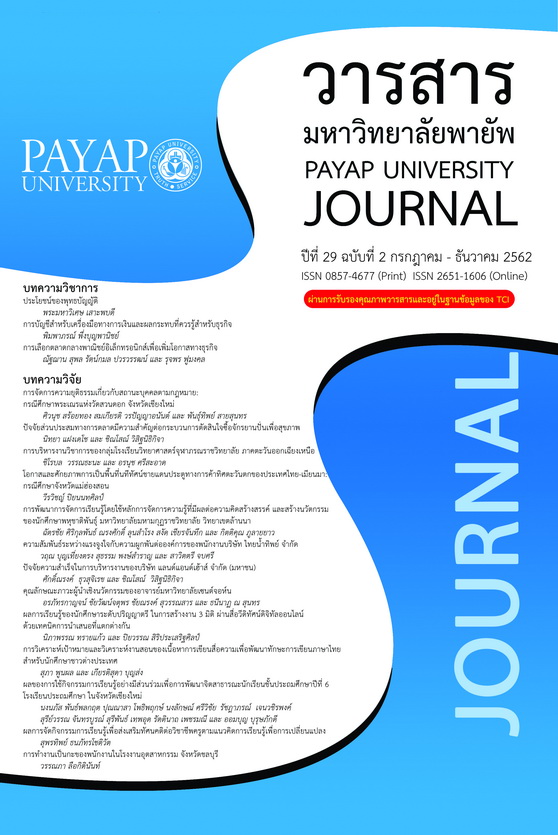โอกาสและศักยภาพการเป็นพื้นที่นทีทัศน์ชายแดนประตูทางการค้า ทิศตะวันตกของประเทศไทย-เมียนมา: กรณีศึกษาจังหวัดแม่ฮ่องสอน
Main Article Content
บทคัดย่อ
การวิจัยครั้งนี้มีวัตถุประสงค์ (1) เพื่อศึกษาโอกาสและศักยภาพจังหวัดแม่ฮ่องสอนและจุดผ่อนปรนทางการค้าในพื้นที่ในการพัฒนาให้เป็นเขตเศรษฐกิจรูปแบบของจุดผ่านแดนถาวรฝั่งทิศตะวันตกของประเทศไทย และ (2) เพื่อศึกษาผลกระทบของการพัฒนาเขตเศรษฐกิจรูปแบบของการเปิดด่านจุดผ่านแดนถาวรเพื่อเป็นประตูทางการค้าทิศตะวันตกของประเทศไทย กลุ่มตัวอย่าง 1) ผู้บริหารหน่วยงานภาครัฐและเอกชนที่เกี่ยวข้องกับการดำเนินการ 30 คน 2) ผู้ประกอบการที่ขึ้นทะเบียนการค้าชายแดนกับสำนักงานพาณิชย์จังหวัดแม่ฮ่องสอน 30 คน และ 3) ประชากรที่มีรายชื่อในทะเบียนบ้านสำมะโนครัวในพื้นที่จังหวัดแม่ฮ่องสอน 425 คน รวมจำนวนกลุ่มตัวอย่าง 485 คน โดยใช้แบบสอบถามเป็นเครื่องมือเก็บรวบรวมข้อมูล
ผลการวิจัยพบว่า โอกาสและศักยภาพการเป็นพื้นที่นทีทัศน์ชายแดนประตูทางการค้าทิศตะวันตกของประเทศไทย-เมียนมา ภาพรวมอยู่ในระดับความคิดเห็นมาก ( = 3.65, S.D. = 0.79)
โดยมีจุดแข็ง คือ การมีพื้นที่ติดต่อกับรัฐสำคัญทั้ง 3 รัฐ ประกอบด้วย รัฐกะเหรี่ยง รัฐคะยา และรัฐฉานและโอกาส คือ รัฐบาลไทยและรัฐบาลเมียนมามีนโยบายการส่งเสริมและผลักดันให้เปิดเป็นด่านการค้าชายแดนถาวร และผลกระทบการเป็นพื้นที่นทีทัศน์ชายแดนประตูทางการค้าทิศตะวันตกของประเทศไทย-เมียนมา ภาพรวมอยู่ในระดับความคิดเห็นมาก ( = 3.61, S.D. = 0.87) กล่าวคือ จะส่งผลกระทบในด้านบวก ทางด้านการศึกษา ภาษา วัฒนธรรมและประเพณี ด้านการพัฒนาคุณภาพชีวิต และด้านเศรษฐกิจ
Article Details
References
กลุ่มงานบริหารยุทธศาสตร์กลุ่มจังหวัดภาคเหนือตอนบน 1 กลุ่มยุทธศาสตร์การพัฒนาภาคเหนือ. (2555). สภาพทั่วไปจังหวัดแม่ฮ่องสอน, สืบค้นเมื่อ 21 กรกฎาคม 2560. http://www.osmnorth-n1.moi.go.th/new/adminsk/filedetailweb/MjAxMzEyMDUwNTM1NTU=d.pdf.
จักรกริช สังขมณี. (2551). พรมแดนศึกษาและมานุษยวิทยาชายแดน: การเปิดพื้นที่สร้างเขตแดน และการข้ามพรมแดนของความรู้. วารสารสังคมศาสตร์. 20(2), 209-266.
จังหวัดแม่ฮ่องสอน. (2560). ยุทธศาสตร์การพัฒนาจังหวัด, สืบค้นเมื่อ 20 กรกฎาคม 2560. http://www.maehongson.go.th/th/province-strategy/strategy-plan.html.
จินตนา บุญบงการ. (2552). สภาพแวดล้อมทางธุรกิจ (พิมพ์ครั้งที่ 8). กรุงเทพฯ: วี.พริ้นท์ (1991).
ชิตพล ชัยมะดัน และศรุติ สกุลรัตน์. (2558). นโยบายการค้าชายแดนไทย-กัมพูชากับการปรับตัวเข้าสู่ประชาคมอาเซียน: กรณีศึกษาจังหวัดสระแก้ว. วารสารราชพฤกษ์. 13(3), 76-85.
ณัฐวัฒน์ ขันโท. (2557). คุณภาพชีวิตของประชาชนในพื้นที่หน่วยบริการชุมชนคลินิกศูนย์แพทย์วัฒนา. วิทยานิพนธ์รัฐประศาสนศาสตรมหาบัณฑิต มหาวิทยาลัยบูรพา. สืบค้นเมื่อ 15 สิงหาคม 2560. http://digital_collect .lib.buu.ac.th/dcms/files/54930398.pdf.
บูฆอรี ยีหมะ. (2554). ความรู้เบื้องต้นทางรัฐศาสตร์ (พิมพ์ครั้งที่ 3). กรุงเทพฯ: สำนักพิมพ์แห่งจุฬาลงกรณ์มหาวิทยาลัย.
พศิน แตงจวง, สุทธิดา เชมนะศิริ, นันทิยา พรหมมา, วิศรุต แตงจวง และสุรพงษ์ ชูวัฒนกุล. (2555). การพัฒนาเขตเศรษฐกิจพิเศษตามโครงการเส้นทางเศรษฐกิจใหม่แม่ฮ่องสอน-เมียนมาร์
ปี 2555: กรณีศึกษาจุดผ่อนปรนห้วยต้นนุ่น. เชียงใหม่: คณะศึกษาศาสตร์ มหาวิทยาลัยเชียงใหม่.
ภัทรานิษฐ์ เหมาะทอง, วนิดา ทองโคตร และสุพรรณี อึ้งปัญสัตวงศ์. (2560). การกำหนดขนาดตัวอย่างโดยใช้สูตร Yamane, สืบค้นเมื่อวันที่ 15 กรกฎาคม 2560. http://sc2.kku.ac.th/ stat/statweb/images/Eventpic/60/Seminar/01_9_Yamane.pdf.
ราชกิจจานุเบกษา. (2543). พ.ร.ฎ.กำหนดบริเวณที่ดินป่าแม่สุรินทร์ ป่าแม่เงา และ ป่าแม่สำเพ็ง ในท้องที่ตำบลขุนยวม ตำบลแม่เงา และ ตำบลแม่กิ๊ อำเภอขุนยวม จังหวัดแม่ฮ่องสอน ให้เป็น เขตรักษาพันธุ์สัตว์ป่า พ.ศ. 2543. เล่มที่ 117 ตอนที่ 98ก หน้า 13.
ราชกิจจานุเบกษา. (2560). แผนพัฒนาเศรษฐกิจและสังคมแห่งชาติฉบับที่ 12, สืบค้นเมื่อ 15 กรกฎาคม 2560. http://www.ratchakitcha.soc.go.th/DATA/PDF/2559/A/115/1.PDF.
วีรวิชญ์ ปิยนนทศิลป์. (2559). การบริหารจัดการยุคใหม่และภาวะผู้นำ. เชียงใหม่: ปภาวีการพิมพ์.
ศูนย์สั่งการชายแดนไทยกับประเทศเพื่อนบ้านด้านเมียนมา จังหวัดแม่ฮ่องสอน. (2555). บทสรุปผู้บริหาร สถานการณ์ชายแดนจังหวัดแม่ฮ่องสอน, สืบค้นเมื่อ 30 มกราคม 2555. https://www.ect.go.th /maehongson/ewt_dl.php?nid=80.
ส่วนความร่วมมือภาครัฐและเอกชน. (2558). โครงการประชุมสัมมนาเปิดประตูการค้า การลงทุน และการท่องเที่ยวด่านห้วยต้นนุ่น จังหวัดแม่ฮ่องสอน เชื่อมโยงสู่เมียนมา, สืบค้นเมื่อ 20 กรกฎาคม 2560. http://www.jpp.moi.go.th/media/files/26_06_58_1.doc.
สภาความมั่นคงแห่งชาติ. (2559). แผนบริหารจัดการชายแดนด้านความมั่นคง พ.ศ.2559-2564, สืบค้นเมื่อ 18 สิงหาคม 2560. http://www.nsc.go.th/Download1/.pdf.
สำนักงานคณะกรรมการพัฒนาเศรษฐกิจและสังคมแห่งชาติ. (2560). สรุปสาระสำคัญแผนพัฒนาเศรษฐกิจและสังคมแห่งชาติฉบับที่ 12, สืบค้นเมื่อ 10 กรกฎาคม 2560. http://www.nesdb.go.th /download/plan12/.pdf.
สำนักงานสาธารณสุขจังหวัดแม่ฮ่องสอน. (2560). ประชากรจังหวัดแม่ฮ่องสอนปี 2560, สืบค้นเมื่อวันที่ 10 กรกฎาคม 2560. http://www.mhso.moph.go.th/mhs/index.php/2012-12-27-07-26-41/2012-12-27-07-27-58/15-peopledata.
สุณัฐวีย์ น้อยโสภา. (2557). บทบาทของการค้าระหว่างประเทศผ่านชายแดนทางบกของประเทศไทย. วารสารวิชาการมหาวิทยาลัยธนบุรี, 8(3), 118 - 126.
Grundy-Warr, C., & Wong Siew Yin, E. (2002). Geographies of Displacement: The Karenni and The Shan Across The Myanmar-Thailand Border. Singapore Journal of Tropical Geography, 23(1), 93-122.
Legge, K. (1995). What is human resource management?. In Human resource Management. Palgrave, London.
Patrick, D. L., & Erickson, P. (1993). Health status and health policy: quality of life in health care evaluation and resource allocation. New York: Oxford University Press.
Schneider, S. C. (1988). National vs. corporate culture: Implications for human resource management. Human resource management, 27(2), 231-246.
Than, M. (2005). Myanmar's Cross-Border Economic Relations and Cooperation with the People's Republic of China and Thailand in the Greater Mekong Subregion. Journal of GMS Development Studies, Vol. 2, 37-54.

